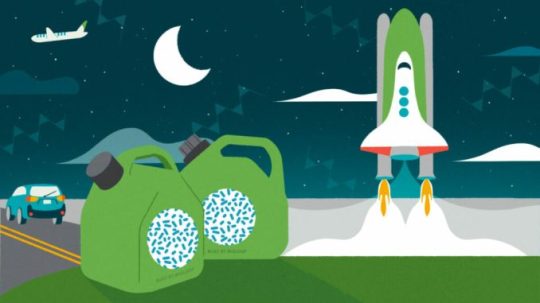#BerkeleyLab
Explore tagged Tumblr posts
Text
Elaboran mapa más grande de universo sobre origen de aceleración cósmica
Un equipo de investigadores del @BerkeleyLab han utilizado el Instrumento Espectroscópico de Energía Oscura para crear el mapa 3D más grande de nuestro universo y mediciones líderes en el mundo de la energía oscura, la misteriosa causa de su acelerada expansión.
Agencia/Ciudad de México.- El primer año de funcionamiento del Instrumento Espectroscópico de Energía Oscura (DESI) sugiere que hay más por aprender sobre la causa o causas subyacentes de la aceleración cósmica. Ubicado en el Observatorio Kitt Peak en Arizona, DESI recolecta luz de las partes más distantes del universo, lo que permite a los científicos cartografiar el cosmos tal como era en su…

View On WordPress
0 notes
Text
Dai batteri un biocarburante ad elevata energia

Il biocarburante del futuro fatto con i batteri è migliore perfino del jet fuel. I ricercatori del Berkeley Lab hanno utilizzato alcuni batteri per la produzione di un nuovo biocarburante con una densità energetica significativamente superiore a quella del carburante per aerei. Le molecole del nuovo carburante sono note come esteri metilici di acidi grassi policiclopropanati (POP-FAME) e sono costituiti da sette serie di anelli di ciclopropano. Si tratta di anelli di tre atomi di carbonio legati in forma triangolare, che costringono i legami a formare un angolo di 60 gradi. I ceppi di questo angolo acuto contengono un’elevata energia potenziale che può essere rilasciata durante la combustione.

Gli scienziati hanno identificato i batteri naturali che producono ciclopropano in una famiglia chiamata streptomyces. Il risultato finale della ricarerca, come pubblicato su Joule, è stato quello di ottenere molecole POP-FAME che il team ha chiamato fuelimycins, che richiedono solo un’ulteriore fase di lavorazione chimica per essere trasformate in un carburante pronto per la combustione. E’ un supercarburante biologico Gli scienziati dei Sandia National Labs hanno poi condotto simulazioni al computer con i carburanti ottenuti, per stimarne le proprietà rispetto ai carburanti convenzionali. L’analisi ha suggerito che i nuovi combustibili avrebbero una densità energetica di oltre 50 megajoule per litro (MJ/L). Un numero decisamente interessante se si pensa che la densità energetica della benzina è di circa 32 MJ/L, mentre nei carburanti per jet e razzi è attorno ai 35 MJ/L.

Questa maggiore densità energetica potrebbe aiutare le auto a fare più strada con la stessa quantitò di carburante, ma anche a ridurre la quantità di carburante necessaria per i lanci dei razzi, risparmiando spazio e peso per il carico. Impatto ambientale ridotto Allo stesso tempo, la produzione dei carburanti dai batteri riduce l’impatto ambientale. Poiché questi carburanti sono prodotti da batteri alimentati con materia vegetale la loro combustione nei motori ridurrà significativamente la quantità di gas serra aggiunti rispetto a qualsiasi carburante generato dal petrolio. C’è da dire che ovviamente, questi biocarburanti non sono ancora pronti per l’uso. Il team deve trovare il modo di produrre quantità maggiori per poterle testare nei motori, ingegnerizzando il processo in ceppi batterici più efficienti. Inoltre, hanno in programma di studiare modi per produrre molecole di lunghezza diversa per scopi diversi. I carburanti a catena più lunga sarebbero solidi, adatti come carburante per razzi, le catene più corte potrebbero essere migliori per il carburante per jet e nel mezzo potrebbe esserci una molecola alternativa al diesel. Read the full article
#atomidicarbonio#batteri#BerkeleyLab#biocarburante#biodiesel#biologico#ciclopropano#diesel#fuelimycins#greendeal#greenfuel#jetfuel#materiavegetale#molecolePOP-FAME#policiclopropanati#supercarburante
0 notes
Photo

The City, Alcatraz, the BB, the GG, Berkeley, Sather Tower, and Wang Hall #berkeleylab #nersc #hpc #ucberkeley #turkeys (at Lawrence Berkeley National Laboratory) https://www.instagram.com/p/CFNU-AIhi_D/?igshid=1rl0uko114629
0 notes
Text
Magic Leap is experimenting with light-bending nanomaterials
Magic Leap is experimenting with light-bending nanomaterials
Mixed reality company Magic Leap is cagey with its tech, to say the least. However, it has released a research paper in conjunction with Berkeley Lab that hints on what it’s doing. The team developed new materials that can take in light from more angles than before and redirect it with minimal losses. That could aid not only its mixed reality (MR) headset, which reportedly uses wave-guiding tech…
View On WordPress
#berkeleylab#cameras#gear#holograms#invisibilitycloaks#light#magicleap#metamaterials#nanotechnology#wearables
0 notes
Text
New computer models could direct scientists to epic cosmic events
New computer models could direct scientists to epic cosmic events

Now that they're spotting gravitational waves more often, scientists are expanding their search for cosmic events. Specifically, they're using new computer models to depict the cataclysmic collision that occurs when a black hole joins a neutron star… Read entire story.
Source: Engadget RSS Feed
View On WordPress
0 notes
Text
Computational tool enables scientists to evaluate and enhance quality of viral genomes

- By Karina Toledo , Agência FAPESP -
Researchers working in the United States have developed a computational tool that can be used to evaluate and enhance the quality of viral genomes obtained by means of metagenomics, a technique for sequencing all the genetic material present in environmental samples (of soil or water, for example), and identifying by bioinformatics the organisms to which the sequences belong.
An article published in Nature Biotechnology reports the findings of the research, which was conducted at the US Department of Energy’s Joint Genome Institute and led by Nikos Kyrpides and Stephen Nayfach. One of its co-authors was Antônio Pedro Camargo, a doctoral fellow at the State University of Campinas’s Institute of Biology (IB-UNICAMP) in Brazil with a scholarship from FAPESP. The tool is called CheckV, and can be downloaded free of charge from http://bitbucket.org/berkeleylab/CheckV.
“Metagenomics has permitted a huge advance in the knowledge of microbial biodiversity,” Camargo told Agência FAPESP. “More than 40% of known bacterial species have been described recently thanks to this type of approach. However, we still know very little about viruses. Most of the genomes sequenced are from human pathogens. We want to know more about bacteriophages [viruses that infect bacteria]. They’re the most abundant biological entities on Earth and play an important role in regulating ecosystems.”
A large proportion of the microorganisms that participate in the cycling of carbon, nitrogen, sulfur, and other nutrients are regulated by viruses in their natural environments. Metagenomics can help scientists retrieve the genomes of these viruses and associate them with their microbial hosts.
“However, the technique is subject to errors and incompleteness,” Camargo said. “The sequences obtained for the analysis of environmental samples are often fragmented, incomplete, or contaminated by genetic material from host bacteria. For this reason, for several years scientists have been looking for ways to control the quality of the results obtained by metagenomics.”
Viruses evolve far more quickly than cellular organisms and have highly plastic genomes, he added. A bacteriophage will often “steal” genes from its host bacterium or from another virus by which the host is also infected.
“Most bacteriophages have a circular genome that’s integrated into the host bacterium’s genome,” he said. “The tool can measure the degree to which the viral sequences are contaminated and separate the genetic material of the virus from that of the bacterium by analyzing an environmental sample using metagenomics.”
CheckV can also show how complete the sequence obtained is. According to Camargo, this is possible because the genome’s size is relatively conserved among similar viruses as it is limited by the capsid, the protein envelope that protects their genetic material.
“The tool compares the size of the sequence obtained by means of metagenomics with the expected template for the group. If half of it is detected, for example, the tool shows us that it’s 50% complete,” he explained.
To validate CheckV, the group led by Kyrpides and Nayfach used two databases containing sequences for viruses not cultured in a laboratory but obtained by sequencing environmental samples: Integrated Microbial Genomes (IMG/VR), and Global Ocean Virome 2.0. The tool identified a total of 44,652 complete or almost complete viral genomes in both collections (3.6% of the volume analyzed), separating them from the vast majority of other sequences, which were fragmented or incomplete.
CheckV also identified some 17,000 viral sequences in IMG/VR that were integrated into the genomes of host bacteria, separating viral and host genetic material to find out which genes encoded by viruses modulated bacterial metabolisms.
Beneficial microbes
In his Ph.D. research, Camargo has focused on studying bacteria that both thrive in adverse environments and somehow help plants survive in situations where nutrients are limited. The principal investigators for the project are Marcelo Falsarella Carazzolle and Paulo Arruda, professors at IB-USP and members of the Genomics for Climate Change Research Center (GCCRC), an Engineering Research Center (ERC) established by FAPESP and the Brazilian Agricultural Research Corporation (EMBRAPA) at UNICAMP.
“Plants and animals are full of microorganisms that create a functional link with their hosts and can benefit the individual’s defense system, nutrition, and overall health. One of the main challenges of researching the microbiome is identifying the mechanisms whereby beneficial microbial communities interact with host organisms to modulate their performance,” Arruda told Agência FAPESP.
Mass sequencing of metagenomes and metatranscriptomes (sets of RNA molecules expressed in environmental samples) has revealed significant diversity of DNA and RNA viruses that belong to the microbiota of plants and humans, as well as many new functions regulated by the microbial communities of their hosts, Arruda explained.
“Understanding the role of these viral communities in the functioning and evolution of organisms is the next challenge. New computational tools that enable us to analyze organisms’ viromes more accurately and efficiently are fundamental to the development of this vital area of the life sciences,” said Arruda, who is Project Leader at GRCCRC.
The article “CheckV assesses the quality and completeness of metagenome-assembled viral genomes” is at: www.nature.com/articles/s41587-020-00774-7.
This text was originally published by FAPESP Agency according to Creative Commons license CC-BY-NC-ND. Read the original here.
--
Read Also
eDNA sequencing will enable scientists to explore piscine diversity in the Amazon without catching fish
#genomics#computing#dna#rna#bacteria#nature#genomes#genetics#environment#bioinformatics#checkv#bacteriophages#metagenomics
0 notes
Text
Ancient pigment can boost energy efficiency
Credit: iStock/Freeartist
A color established by Egyptians countless years back has a modern-day application also– the pigment can boost energy efficiency by cooling roofs and walls, and might likewise make it possible for solar generation of electrical power by means of windows.
Egyptian blue, stemmed from calcium copper silicate, was regularly utilized on ancient representations of gods and royalty. Previous research studies have actually revealed that when Egyptian blue soaks up noticeable light, it then releases light in the near-infrared variety. Now a group led by scientists at the Department of Energy’s Lawrence Berkeley National Laboratory (BerkeleyLab) has actually validated the pigment’s fluorescence can be 10 times more powerful than formerly believed.
.
Measuring the temperature level of surface areas covered in Egyptian blue and associated substances while they are exposed to sunshine, Berkeley Lab scientists discovered the fluorescent blues can release almost 100 percent as lots of photons as they take in. The energy efficiency of the emission procedure depends on 70 percent (the infrared photons bring less energy than noticeable photons).
.
The finding contributes to insights about which colors are most efficient for cooling roofs and exteriors in warm environments. Though white is the most standard and efficient option for keeping a structure cool by showing sunshine and lowering energy usage for cooling, structure owners typically need non-white colors for visual factors. For example, bright-white asphalt shingles are practically never ever utilized on sloping property roofings.
.
BerkeleyLab researchers determined the temperature level increase above air temperature level observed completely sun for 5 pigment- layered samples, each 75 millimeters square. The white and black samples reveal low and heats. Credit: BerkeleyLab
BerkeleyLab scientists have actually currently revealed that fluorescent ruby red pigments can be a reliable option to white; this insight on Egyptian blue contributes to the menu of cooling color options. Further, they discovered that fluorescent green and black colors can be produced with yellow and orange co-pigments. The brand-new findings were just recently released in the Journal of Applied Physics
.
In addition to its cooling capacity for structures, Egyptian blue’s fluorescence might likewise work in producing solarenergy Used on windows tinted with the blue, solar batteries on the edges can transform the fluoresced near-infrared energy to electrical power.
.
Substantial research study for many years from Berkeley Lab’s Heat Island Group has actually discovered that reflective roofings and walls can cool structures and vehicles. This minimizes the requirement for cooling and reduces the city heat island result. By showing the sun’s rays back to space, these cool products likewise launch less heat into the environment, therefore cooling the world and balancing out the warming results of significant quantities of greenhouse gas emissions.
Explore even more: Fluorescent ruby red roofings remain as cool as white.
. More details: PaulBerdahl et al. High quantum yield of the Egyptian blue household of infrared phosphors (MCuSi 4 O10, M = Ca, Sr, Ba), Journal of Applied Physics(2018). DOI: 10.1063/ 1.5019808
.
SarahMichaud. Quantum yield of Egyptian- blue IR phosphors determined utilizing temperature level modifications in sunshine, Scilight(2018). DOI: 10.1063/ 1.5040060
Journal referral: Journal of AppliedPhysics
Provided by: LawrenceBerkeley NationalLaboratory
New post published on: https://livescience.tech/2018/10/10/ancient-pigment-can-boost-energy-efficiency/
0 notes
Photo

My photo of the later model Monarch 10EE with the rare longer 30" bed when I toured the Lawrence Berkeley National Laboratory. Https://www.Machinistlife.com #monarchlathe #metallathe #monarch10ee #berkeley #berkeleyca #berkeleylab #machinist #machining #Metalworking #oldtools #toolporn #machinistporn #machinists #machineporn #machinistlife
10 notes
·
View notes
Photo

Some (very careful) assembly required; working with hazardous chemicals in the Battery Fabrication Laboratory. #lbnlphotowalk @berkeleylab @ucberkeleyofficial #ricohgr #blackandwhite (at Berkeley Lab)
1 note
·
View note
Text
Se descodifica el rompecabezas masivo de las primeras estrellas
Un nuevo estudio ha obtenido avances sustanciales en la decodificación de la masa de nacimiento de las primeras estrellas utilizando la potente supercomputadora del @BerkeleyLab.
Agencias, Ciudad de México.- Un nuevo estudio ha obtenido avances sustanciales en la decodificación de la masa de nacimiento de las primeras estrellas utilizando la potente supercomputadora del Berkeley Lab. Ching-Yao Tang y Ke-Jung Chen, del Instituto de Astronomía y Astrofísica de la Academia Sínica (ASIAA), han creado las primeras simulaciones hidrodinámicas en 3D de alta resolución en el…

View On WordPress
0 notes
Photo

Iris Identity #supercomputing #nersc #berkeleylab (at Berkeley, California) https://www.instagram.com/p/B5ZYwqyh9pd/?igshid=mb7priqy8f0e
0 notes
Photo

“Magic mirror in my hand, which tooth has the biggest cavity?”
0 notes
Photo

#Science: #photosynthesis, like a #moss 😉 ► https://ift.tt/2RpGDzv via @BerkeleyLab
0 notes
Link
Berkeley Lab (@BerkeleyLab)
Computer simulations are painstakingly sloooooooooooow... DYK one simulation can take up to a million CPU hours? Re… https://t.co/2iNli7bCc4
faved by your 1 friend
0 notes
Text
Científicos advierten que llegará la categoría 6 para la escala de huracanes
Un equipo de investigadores del @BerkeleyLab están considerando una categoría 6 para la escala de huracanes.
Agencias, Ciudad de México.- Científicos del clima han planteado incluir una categoría 6 en la escala de riesgo de daños por huracanes porque la subida de temperaturas del océano contribuye a tormentas más destructivas. Durante más de 50 años, el National Hurricane Center (NHC) de EEUU ha utilizado la escala de viento Saffir-Simpson para comunicar el riesgo de daños a la propiedad; etiqueta un…

View On WordPress
0 notes